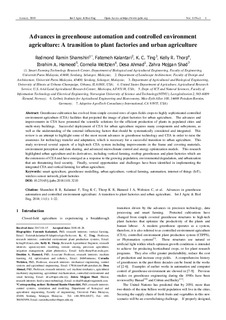| dc.contributor.author | R. Shamshiri, Redmond | |
| dc.contributor.author | Kalantari, Fatemeh | |
| dc.contributor.author | Ting, K. C. | |
| dc.contributor.author | Thorp, Kelly R. | |
| dc.contributor.author | Hameed, Ibrahim A. | |
| dc.contributor.author | Weltzien, Cornelia | |
| dc.contributor.author | Ahmad, Desa | |
| dc.contributor.author | Shad, Zahra Mojgan | |
| dc.date.accessioned | 2019-02-28T07:56:04Z | |
| dc.date.available | 2019-02-28T07:56:04Z | |
| dc.date.created | 2019-01-22T11:39:27Z | |
| dc.date.issued | 2018 | |
| dc.identifier.citation | International Journal of Agricultural and Biological Engineering. 2018, 11 (1), 1-22. | nb_NO |
| dc.identifier.issn | 1934-6344 | |
| dc.identifier.uri | http://hdl.handle.net/11250/2587902 | |
| dc.description.abstract | Greenhouse cultivation has evolved from simple covered rows of open-fields crops to highly sophisticated controlled environment agriculture (CEA) facilities that projected the image of plant factories for urban agriculture. The advances and improvements in CEA have promoted the scientific solutions for the efficient production of plants in populated cities and multi-story buildings. Successful deployment of CEA for urban agriculture requires many components and subsystems, as well as the understanding of the external influencing factors that should be systematically considered and integrated. This review is an attempt to highlight some of the most recent advances in greenhouse technology and CEA in order to raise the awareness for technology transfer and adaptation, which is necessary for a successful transition to urban agriculture. This study reviewed several aspects of a high-tech CEA system including improvements in the frame and covering materials, environment perception and data sharing, and advanced microclimate control and energy optimization models. This research highlighted urban agriculture and its derivatives, including vertical farming, rooftop greenhouses and plant factories which are the extensions of CEA and have emerged as a response to the growing population, environmental degradation, and urbanization that are threatening food security. Finally, several opportunities and challenges have been identified in implementing the integrated CEA and vertical farming for urban agriculture. | nb_NO |
| dc.language.iso | eng | nb_NO |
| dc.publisher | ABE Publishing | nb_NO |
| dc.rights | Navngivelse 4.0 Internasjonal | * |
| dc.rights.uri | http://creativecommons.org/licenses/by/4.0/deed.no | * |
| dc.title | Advances in greenhouse automation and controlled environment agriculture: A transition to plant factories and urban agriculture | nb_NO |
| dc.type | Journal article | nb_NO |
| dc.type | Peer reviewed | nb_NO |
| dc.description.version | publishedVersion | nb_NO |
| dc.source.pagenumber | 1-22 | nb_NO |
| dc.source.volume | 11 | nb_NO |
| dc.source.journal | International Journal of Agricultural and Biological Engineering | nb_NO |
| dc.source.issue | 1 | nb_NO |
| dc.identifier.doi | 10.25165/j.ijabe.20181101.3210 | |
| dc.identifier.cristin | 1662842 | |
| dc.description.localcode | © 2018 Copyright ABE Publishing. This article is an open access article distributed under the terms and conditions of the Creative Commons Attribution (CC BY) license (http://creativecommons.org/licenses/by/4.0/). | nb_NO |
| cristin.unitcode | 194,63,55,0 | |
| cristin.unitname | Institutt for IKT og realfag | |
| cristin.ispublished | true | |
| cristin.fulltext | original | |
| cristin.qualitycode | 1 | |

